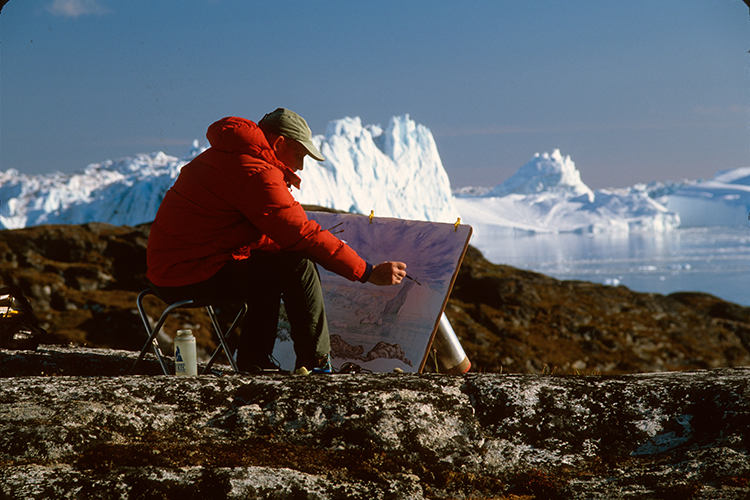
Watercolour artist Tony Foster talks to Bryony Cottam about why he paints in the wild
 Tony’s travel insights
Tony’s travel insights
• Beware of romantic misconceptions about the wilderness
• Travel with purpose – it provides focus and meaning
• Become part of the landscape to see what others often miss
At more than 5,000 metres altitude, on the south face of Mount Everest, Tony Foster was struck down with pulmonary and cerebral oedema. ‘Acute altitude sickness – serious trouble.’ It was only by the skin of his teeth, he says, that he survived. ‘Funnily enough, the Sherpas accompanying me looked even more disappointed than I felt about not completing my painting. So I promised them I would go back to finish it, and I did.’
Foster, a British watercolour artist based in Cornwall, returned the next year. His mission: to paint the world’s tallest mountain in situ, equipped with just a tiny paint box the size of a cigarette packet. Even with these limited supplies, Foster has produced watercolour landscapes, all painted ‘en plein air’, that can reach nearly two metres long. ‘The main component of watercolours is water, and you can usually find some wherever you are – unless you’re in a desert.’ It’s a medium that has allowed him to paint in some very unusual, often quite hostile places. As well as returning three times to Everest, Foster has travelled on foot, by raft or canoe to create art all over the world, from the arid deserts of the American West to rainforests in Costa Rica and volcanic landscapes in Bolivia.
Enjoying this article? Check out our related reads…
Foster’s passion for wild places emerged during one of his earliest journeys as he traced the steps of Henry David Thoreau through the forests and lakesides of Maine, USA, and found himself, for the first time, fully immersed in nature. ‘I suddenly discovered that wilderness actually existed. And I guess I’ve been looking for it ever since.’
Forty years later, however, Foster reflects on a common misconception many tourists share: their initial, often Western-influenced ideas of pristine, untouched wilderness are frequently far from reality. He admits: ‘I’ve come to realise that I had this romantic idea about places that looked untouched. I thought of them as wilderness, but in fact most so-called wildernesses have been inhabited by people for thousands of years.’ Nonetheless, his paintings consistently depict places where nature, not humans, is dominant, and where the communities that call these wild spaces home are connected to and coexist with their natural surroundings.

While many travellers and explorers see travel as its own goal, every trip Foster takes has a specific purpose. ‘I only travel to paint. Someone once said, “Oh, that’s a great way to pay for your adventures, isn’t it?” But that’s not the point. It’s the other way around – I travel in order to paint.’ Even on regular holidays, which Foster insists he takes from time to time, he usually manages to slip a small sketchbook into his luggage. ‘My wife generally tries to stop me.’
He struggles to choose a favourite destination among the many that he’s visited, pointing out that many of his most memorable moments have happened in some of the least obvious places. ‘The rainforest is the most uncomfortable place to sit and work. You’re covered in mud, your clothes are wet, you have to put athlete’s foot powder in your belly button to stop it from going moldy, and you’re being bitten by something all the time. But on the other hand, it is absolutely fascinating.’
Sitting quietly and painting, day after day, Foster found that, as far as the wildlife was concerned, he soon became just another part of the forest. Tapirs browsed the vegetation growing next to his easel and a giant anteater stopped to sniff at his boots. ‘On many occasions, I’ve seen things that scientists at local research stations haven’t spotted as they go about their work in the forest.’
Upcoming events:
Tony Foster: Painting at the Edge
Directed by David C. Schendel
Travelling mostly on foot, by raft or canoe, English artist Tony Foster paints landscapes in the remotest of areas often risking his life to bring awareness to wilderness destruction and climate change.
At selected cinemas from 16 November 2025
Exploring Time: A Painter’s Perspective’ by Tony Foster
Tony Foster is known for his remarkable ‘Journeys’, watercolour painting expeditions that take place over many years where he reflects on and responds to remote wild places across the world. This new exhibition presents over fifty watercolours painted en plein air over seventeen years, sharing the artist’s reflections on the complexity of time and its impact upon the planet. Each includes notes from the artist’s experiences as well as maps and objects relevant to its location. Divided into Geological Time, Biological Time, Human Time and Fleeting Moments, the paintings explore how time has sculpted and affected our planet. From Colorado to Tibet, the Galapagos and Cornwall, the works celebrate the wonder of nature, highlighting the importance of leaving areas of the world undisturbed.
Dates: Friday 7 November – Saturday 20 December 2025
Venue: RWS Gallery, 3-5 Whitcomb Street, London WC2H 7HA
Opening times: 11am – 5pm daily
Admission: Free entry
Contact: 020 8050 9425 [email protected]




